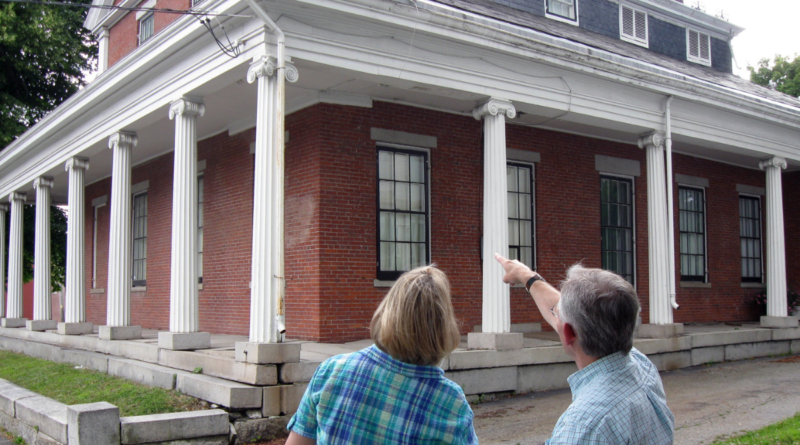An 87-year-old slice of cake and other weird items at the Bangor Historical Society – Bangor Daily News
Bangor Daily News
Maine news, sports, politics, election results, and obituaries
Hard Telling Not Knowing each week tries to answer your burning questions about why things are the way they are in Maine — specifically about Maine culture and history, both long ago and recent, large and small, important and silly. Send your questions to eburnham@bangordailynews.com.
There are more than 40,000 items in the Bangor Historical Society’s collection, including Civil War-era artifacts, paintings, documents, a vast array of antique clothing, housewares and furniture and other objects.
Among them are some truly one-of-a-kind items — from artifacts left over from the era in which Bangor had five busy theaters, to shoes that could fit Paul Bunyan, to the oldest piece of cake you’ve probably ever seen.
The Thomas A. Hill House — which houses the historical society and recently got a major exterior facelift — will reopen on Dec. 6 for Holidays at Hill House. The free holiday celebration is open from 10 a.m. to 6 p.m. Tuesdays through Saturdays through Dec. 21, and features the historic building fully decorated for the season.
Here are six of the most unusual items in the Bangor Historical Society’s collection.
From when it first opened in 1902 to when it was finally demolished during the urban renewal era in 1974, the Bijou Theatre on Exchange Street in downtown Bangor played host to everything from opera singers to boxing matches, vaudeville comedians to the latest movies from Hollywood. In 1910, it became the first Bangor theater to be fully electrified, which in that era was still an incredible achievement in Maine. One of the few remaining artifacts from that time period at the Bijou was an arc lamp, also known as a rectifier, an extremely powerful lamp which in the 1920s was likely used to power the movie projector or to light the stage, and which is held at the BHS.
Among the items donated to the society by Mary McClure, a Bangor woman who died in 2004 at age 96, was a large slice of wedding cake from her Oct. 9, 1937, wedding to James McClure. Matt Bishop, BHS curator, says the 87-year-old slice of cake is in surprisingly good condition for its age, though it is likely not as tasty now as it was on the day that it was served.
Prior to the Civil War, American currency was a mishmash of coins, paper money and other denominations, issued at the federal level all the way down to the local level, and even by private institutions. Banks across the country issued their own private money, including in Maine, where the Farmers Bank of Bangor began issuing its own currency in 1858. A Farmers Bank printing plate at the Bangor Historical Society was used to print $2 bills, which presumably were only accepted in the Bangor region.
The Viner Shoe Company was one of several shoemaking businesses in Bangor throughout the late 19th and 20th century, with its Hancock Street warehouse employing hundreds of people over the years. In the late 1960s, a shoe designer at the company named Ron Newcomb handmade four gigantic leather shoes as a promotional stunt. They were displayed at local stores for years before eventually being donated to the BHS in 2001. The shoes are estimated to be around a size 42 men’s, which is pretty darned big — though compared to the size 410 Bean boot outside L.L. Bean in Freeport, they are positively dainty.
There are lots of unusual items in the Holt/Dunbar collection at the Bangor Historical Society, including animal skulls and rare shells, an ancient stone sculpture of the Buddha, and pieces of ships commanded by the likes of Benedict Arnold and Adm. Robert Peary. Strangest, though, are likely the three silkworm cocoons, obtained by someone in Bangor in the late 1800s via a would-be silk producer in San Francisco named Joseph Neumann. Neumann was one of a handful of people in California between the 1860s and 1880s who tried to establish a silk industry in the U.S. Though that experiment ultimately failed, one wonders how these long-dead silkworms made it all the way from San Francisco to Bangor.
Though Bangor residents knew him best as a local bandleader, musician and owner of a longtime music store downtown, as a young man, Melville Andrews was a soldier during the Civil War. He participated in Gen. Sherman’s infamous March to the Sea in Georgia, which saw Union soldiers burn southern villages all the way to Savannah, where they finally stopped and spared the city in return for its surrender.
In the aftermath, when Union soldiers occupied the city, Andrews entertained people with his trumpet playing, resulting in grateful Savannah citizens gifting him a new cornet, and a hand-carved cane and watch. The silver cornet and the cane — made of local wood and embellished with a carved alligator on the handle — are still held by the BHS.
Emily Burnham is a Maine native and proud Bangorian, covering business, the arts, restaurants and the culture and history of the Bangor region. More by Emily Burnham

